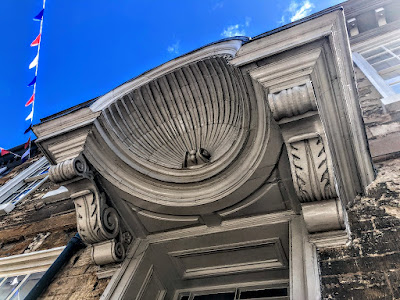Queen Anne House, or Shell House, at 48 High Street, Stony Stratford, was once the Dower House for Wolverton Manor (Photograph: Patrick Comerford, 2022)
Patrick Comerford
One of the most elegant and most intriguing houses in Stony Stratford is almost directly opposite me on the High Street.
Queen Anne House, also known as Shell House, is at 48 High Street. This was once the Dower House for nearby Wolverton Manor, which was demolished in 1728.
The Shell House has many distinct sections, spanning from the 1520s to the early 1700s, with a rare number of original features still intact. The front portion is believed locally to have been underwritten in some way by Sir Christopher Wren or – more likely – his colleague Nicholas Hawksmoor ca 1700-1703.
At dates that would appear to concur with this, Wren and Hawksmoor were sourcing building materials from Stony Stratford while they were working on other estates nearby.
Wren was busy remodelling Winslow Hall to the south in 1700. At the same time, Hawksmoor was working on Easton Neston to the north, which he completed in 1702.
Both men were known personally to the early 18th century owner of Queen Anne House, Dr John Radcliffe, who gives his name to the Radcliffe Camera and the John Radcliffe Hospital in Oxford and who owned vast estates around Wolverton and Stony Stratford.
Wren, Hawksmoor and Radcliffe all belonged to the same masonic circle. Radcliffe, who was Queen Anne’s physician, became the owner of the Shell House in 1713 when he acqured the Wolverton estate.
The scallop shell recesses are a notable feature of the Shell House (Photograph: Patrick Comerford, 2022)
Architecturally, all three properties share features that bear more than a passing resemblance. The drawing room at Queen Anne House has scallop shell recesses that are notably similar to stairwell features at Easton Neston.
Interestingly, the hallway is dominated by a grand oak staircase that has carved inverted pentagrams. Hawksmoor was well known for appropriating symbols like this in his designs to ward off evil. He was sometimes referred to as ‘The Devil’s Architect.’
Despite compelling circumstantial evidence, given the passage of time it is unlikely that direct evidence will be uncovered linking Wren or Hawksmoor to Queen Anne House.
This house on the north-east side of High Street, Stony Stratford is a two-storey ashlar sandstone house with a steep pitched, partly-tiled roof with flat stone coping on the gables, and plain kneelers supported by moulded consoles.
The house has one early and one late brick chimney stack, and two pedimented dormers.
There is a small plinth, with a band at the first floor level, chamfered quoins and a heavy modillion eaves cornice. There are four windows on the first floor, of which the third from the left is blind, three windows on the ground floor, and an entrance under the blind window.
The windows are sash in wooden cases and have narrow wooden architraves. There are plain cills, with a plain lintel on the first floor windows, while heads of the ground floor windows have light carving and keystones.
The entrance is approached by two carved consoles. There is narrow wooden doorcase, panelled reveals and soffit, and panelled door with rectangular light above it. The front room on the ground floor has a door-head with a segmental pediment and a shell niche inside. There are railings in front of the covered area.
I understand that inside the house is panelled throughout on the ground and first floors. Sometimes, when I try to catch a glimpse as I walk by, I can see the fine staircase with applied carved strings, three balusters to a step, exaggerated ramps, and quarter landings.
This elegant house is considerably higher than the two-storey houses south of it, and in relation to No 50, a three-storey house, is almost as high to the eaves and the ridge is higher.
Sometimes I catch a glimpse of the fine staircase (Photograph: Patrick Comerford, 2022)




3 comments:
I Thoroughly enjoyed this blog on Queen Anne's house.
I had a school friend who lived in the house called William and have fond memories of the visits.
A beautiful house one can only dream of owning.
I had the honour of being involved in the selling of this amazing house approximately 8 years ago, now has been modernised sympathetically retaining the original features. What is now the kitchen the rear was believed to be the original medieval structure.
I was the previous owner of this house circa 2011 to 2014. I undertook some significant sympathetic restoration work while there. Some thorough investigations by a historical researcher took place under my watch, but we were unable to uncover more than circumstantial evidence relating to Wren and Hawksmoor.
The architect of Bletchley Park, Gordon Welchman, lived in the house during the second world war. Frequent visits were made by Alan Turing with whom he played chess and discussed improvements to the bombe device. Churchill is very likely to have visited.
Post a Comment